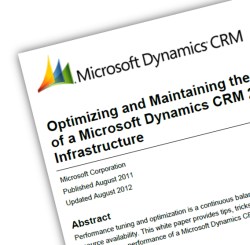Related sites:
Newsletter: Perspectives on Power Platform
Company: Niiranen Advisory Oy
Some time ago I wrote a parody about Dynamics CRM blogs that mainly seem to post news about the latest Update Rollups being released. Now I find myself writing an Update Rollup blog post myself. Is that a sign that I’ve run out of topics and slipped into the autopilot blogging mode? I hope not, but after reading quite a lot about the latest Update Rollup 10 for Dynamics CRM 2011 I decided to contribute a bit into the discussion.
It’s always great to receive improvements to the software you spend all your days working with, isn’t it? Compared to a product like Java which Oracle promises to patch only four times a year, even if it’s about critical security updates (did you remember to uninstall your Java 7 yet?), Microsoft is doing quite an OK job with their update process and we see a steady stream of releases to make Dynamics CRM better one bit at a time. Even though Update Rollup 9 was cancelled after the beta program, MS is now back on track with their release schedule in the form of UR10 that came out two weeks ago.
We have once again a great in-depth article from Dynamics CRM in the Field about all things Update Rollup 10. It tells all the details of the story from Microsoft’s perspective, but let’s evaluate the ups & downs of this latest release from the Dynamics CRM community perspective to get a complete picture, shall we? OK, here goes:
There was quite a number of fixes promised for the CRM Outlook client in Update Rollup 10 that would potentially solve some of the stability issues many users have encountered when trying to use the CRM Outlook client for actual work in their environment. It’s now 2 years since the first beta of the completely rewritten Dynamics CRM Outlook client came out and many of us are certainly hoping that it would have reached a mature enough level where you don’t have to be afraid of if causing a flood of tickets to your helpdesk. Yes, some users may be quite happy with it as it is, but you’d be foolish not to prepare for potential issues when planning a large scale deployment of the Outlook client. Reaching that good ol’ Service Pack 2 type of confidence level would be just great.
 Another promising deliverable from UR10 is the improvements to query performance on large data sets. A new version of the performance optimization whitepaper has been released alongside the update, which describes the new options made available to tune the Quick Find performance. If you read the results of these tests by Chris Cognetta where the query time was decreased by over 80% in an environment with 1.5 million rows, it’s obvious this is an update worth paying attention to if you have or expect to have some “big data” in your CRM system.
Another promising deliverable from UR10 is the improvements to query performance on large data sets. A new version of the performance optimization whitepaper has been released alongside the update, which describes the new options made available to tune the Quick Find performance. If you read the results of these tests by Chris Cognetta where the query time was decreased by over 80% in an environment with 1.5 million rows, it’s obvious this is an update worth paying attention to if you have or expect to have some “big data” in your CRM system.
Finally, as many MSDN subscribers are now eagerly updating their PC’s to run Windows 8, Internet Explorer and even the Office 2013 Preview, the added support for all of these in CRM 2011 Update Rollup 10 is reason enough to grab the very latest CRM bits. Just don’t forget that UR10 alone is not enough, there’s some things you should know about Windows 8 RTM & CRM 2011.
So, we now have a Quick Find that is working faster, which means it must be doing something differently, right? It is, and unfortunately in some cases this will result in a Generic SQL Error message being shown to the user. It appears that the new update is not quite comfortable dealing with a set of Quick Find columns that contains address fields. As some of you may remember, the address 1 & address 2 fields on the account & contact forms are actually not stored in the same database table as the rest of the default fields, rather they reside in the CustomerAddressBase table. The UR10 version of Quick Find may therefore not work properly if you try to search for records based on address fields like city or zip code. Yes, Microsoft says using these as search fields is against best practices, but the users will very often want to narrow down the customer data based on geographic variables, so taking it away from them can only act as a workaround until we have a new hotfix from MS.
CRM developers might not be too concerned with performing actual queries on live customer data, but they will certainly be annoyed when encountering the following prompt after editing a JavaScript web resource: You have exceeded the maximum number of 200 characters in this field; it will be truncated. Doh! Making small changes to script files just became very tedious until Update Rollup 11 rolls along in 2 months time. Again, there’s a workaround to it (don’t use the editor, instead upload the file or use some helpful web resource tool from CodePlex), but it doesn’t really make anyone want to rush UR10 onto all their servers.
Then we have stories of people applying UR10 and finding they can’t access any of their CRM organizations, due to an unhandled exception: Method not found: ‘Void Microsoft.Xrm.Sdk.Query.FilterExpression.set_IsQuickFindFilter(Boolean)’. Uninstalling UR10 appears to be the only known cure for this show stopper, which obviously is related to the aforementioned Quick Find changes on some level.
Alternatively, if you’ve updated your CRM server from 4.0 to 2011, you may experience errors when trying to import a solution file: The element ‘savedquery’ has incomplete content. List of possible elements expected: ‘LocalizedNames’. Manually editing the XML to remove a view prior to importing the file is the available workaround, but again it can make the life of a system customizer quite difficult until there’s a fix available.
The short answer is: always test first, then evaluate the ups & downs for your particular case. If you are struggling with the Outlook client, face performance issues with your huge CRM database or simply want to run CRM 2011 on Windows 8, going for Update Rollup 10 may be perfectly sensible for you. For someone who doesn’t have a compelling need to update, you may well decide to wait a bit longer and no one should blame you for it.
 That’s pretty much how it is with any Update Rollup. In reality there’s never going to be the perfect time to update. Knowing ahead what hotfixes will deliver the biggest gains for you or potentially break your CRM deployment would be a great skill to have. Instead of dreaming about it, here’s a few guiding principles I would recommend you to follow:
That’s pretty much how it is with any Update Rollup. In reality there’s never going to be the perfect time to update. Knowing ahead what hotfixes will deliver the biggest gains for you or potentially break your CRM deployment would be a great skill to have. Instead of dreaming about it, here’s a few guiding principles I would recommend you to follow:
Do you have any words of advise for people who are struggling with the “should I update to Update Rollup X” question? What’s your survival strategy?
Edit 2012-09-09: Based on the discussions on the Dynamics CRM Forum, I’ve created a new wiki page for Microsoft Dynamics CRM 2011 Update Rollup 10 on the CRM Wiki on Technet. The purpose is to provide a single place where the Dynamics CRM community members could share their information on potential issues and known problems that they encounter when applying the latest Update Rollups, as well as naturally links to any solutions or workarounds that can help others who are struggling with the same problem. I’ve initially added links to 10 suspected issues with UR10, but you are very welcome to contribute by adding new links or additional information to the wiki page. In an ideal world, we could have similar pages for each new rollup that gets released and be able to more easily identify both the benefits and the dangers or applying the updates into our CRM environments. Let’s see if the wiki can serve us as a platform for such information sharing.
Jukka-
Thank you for this extremely comprehensive post. I wish I could count on someone to perform this sort of analysis for every rollup.
Jukka,
I ran into the same issue after upgrading to UR10 and got the error “Method not found: ‘Void Microsoft.Xrm.Sdk.Query.FilterExpression.set_IsQuickFindFilter(Boolean)’. ” After a little searching on the web, it seems that there is a fix for this. You just have to remove two items from the GAC: Microsoft.Xrm.Sdk and Microsoft.Crm.Sdk. I just had to remove the Microsoft.Xrm.Sdk file in my case. Once I removed it, CRM came up fine.
[quote]
“Running gacutil /u Microsoft.Xrm.Sdk got that removed and solved my issue.
Instead of ProcessExplorer you could directly run “gacutil /l Microsoft.Xrm.Sdk” or “gacutil /l Microsoft.Crm.Sdk”. ”
Source: http://social.microsoft.com/Forums/sk-SK/crmdeployment/thread/9ca1f52c-a7c3-4998-b2d0-07ad32f1b974
[/quote]
Thanks for the tip, Jim. This seems to be one of the most common issues with Update Rollup 10. In fact, based on the post of Shan McArthur and a tweet from @ccellar, it looks like this issue will be solved with an additional hotfix to be included in the CRM Online version of UR10 and that the on-premise version of UR10 will likely get re-released (before it hits Windows Update, as I think it’s not out there yet).
After many false alarms, Update Rollup 10 was finally re-released on October 4th: http://blogs.msdn.com/b/crminthefield/archive/2012/10/04/microsoft-dynamics-crm-2011-update-rollup-10-re-released.aspx
One week later we’ll already have Update Rollup 11 available for download: http://blogs.msdn.com/b/crminthefield/archive/2012/10/04/podcast-and-overview-microsoft-dynamics-crm-2011-update-rollup-11.aspx
If you’ve deployed the original UR10 and suffered from the bugs it contained, installing the re-released version may be a sensible option. For anyone who’s been holding off UR10 deployment it may be best to wait a couple weeks to see the community response to UR11 and deploy that straight away.
CRM Online customers should start to see Update Rollup 10 deployed into their organization on the week starting October 8th. It’s important to note that this will not be the same as UR11 that the on-premise customers will have available for download on October 11th.
The ‘LocalizedNames’ issue on the 8192 views has been a problem for many. Check out the thread here for some fixes.
http://social.microsoft.com/Forums/en-US/crmdeployment/thread/19adc0c0-b888-499d-aa3a-d922e0c691da/
My case with Microsoft was closed with them saying that they would not offer a fix but others said that they are going to do a hotfix.
I just wanted to take a moment to say how much I appreciate your blog posts. They’re always well-written, informative, and keep me coming back for more. Keep up the great work!
Great to hear that! Especially when posted on a 12 year old blog post regarding a technological concept that hasn’t been relevant for years anymore. It makes it seem all somehow worthwhile.